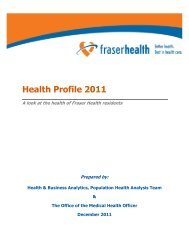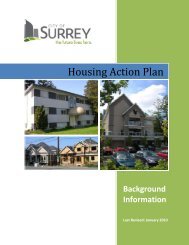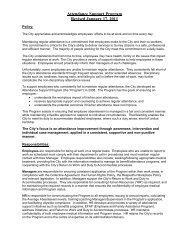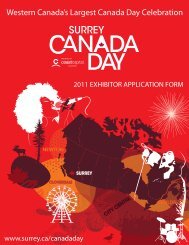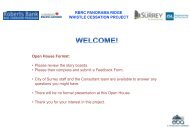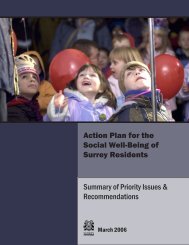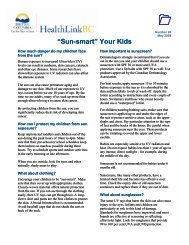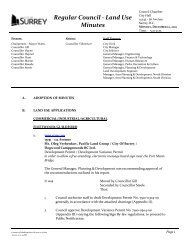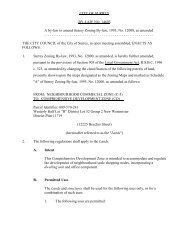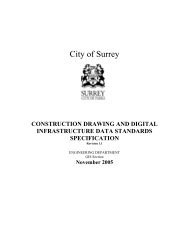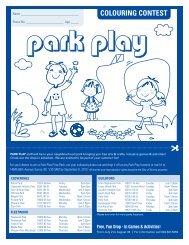Blackie Spit Park: Wildlife Habitat Enhancement Plan - City of Surrey
Blackie Spit Park: Wildlife Habitat Enhancement Plan - City of Surrey
Blackie Spit Park: Wildlife Habitat Enhancement Plan - City of Surrey
Create successful ePaper yourself
Turn your PDF publications into a flip-book with our unique Google optimized e-Paper software.
Management Unit 10: Dune, Grassland, Seral Shrub<br />
1.0 Existing Conditions<br />
Management Unit 10 (Drawing 7) is a dry area that supports vegetation species able to grow under<br />
dry, sandy conditions. Several plant associations occur, forming a progression from the grasses <strong>of</strong><br />
the central, drier area to the forest <strong>of</strong> MU 8. The predominant species in the driest, central areas is<br />
European beachgrass (Ammophila arenaria), with some sweet clover, seedling broom, and<br />
introduced species (Figure 31, across trail, on right).<br />
The second vegetation “zone” is largely introduced European lawn and pasture grasses, and forbs,<br />
including plantain (<strong>Plan</strong>tago lanceolata, P. major), tansy, and tansy ragwort (Senecio jacobaea)<br />
(Figure 31, across trail, on left). Invading woody plants include alder, some blackberry, and<br />
especially Scotch broom.<br />
The third vegetation “zone,” lying between the grasses and woodlot consists primarily <strong>of</strong> blackberries<br />
and knotweed with a few shrubs, such as elderberry or small trees, such as alder, willow, oak, black<br />
hawthorne, and birch (Figure 31, between grass and trees).<br />
2.0 Goals and Objectives<br />
Species Management Goal<br />
Dune and grassland vegetation as cover for cottontails, sparrows, finches, and other wildlife.<br />
Seral shrub land as habitat for sparrows, and small resident passerines (e.g downy woodpeckers,<br />
chickadees, bushtits).<br />
<strong>Habitat</strong> Management Objectives<br />
• Permit dune vegetation community <strong>of</strong> existing introduced grass species to remain;<br />
• <strong>Plan</strong>t native dune vegetation species wherever/whenever revegetation is required;<br />
• Continue to remove invasive woody vegetation, both introduced (e.g. broom, blackberry,<br />
knotweed) and native in dune areas;<br />
• Include information on dune vegetation and ecosystems, and dune management in <strong>Blackie</strong> <strong>Spit</strong><br />
literature;<br />
• Manage invasive species areas between dune and forest as a transitional seral habitat by<br />
controlling invasive species and planting native shrubs and small trees;<br />
• Exclude this MU from dog-<strong>of</strong>f-leash area.<br />
• Reduce trails to one connecting the multi use trail with the west parking lot.<br />
3.0 Management Prescriptions<br />
This unit contains both grass habitats (dune and grass/forb) and a seral shrub habitat. Ecologically,<br />
the seral shrub provides transition zones between the grassland and shrub and between the shrub and<br />
adjacent woodlot. Thus wildlife species common to both transition zones will occur, as well as<br />
species that prefer the shrub. For example, downy woodpeckers and black-capped chickadees will<br />
use the forest and shrub, bushtits will occur most commonly in the shrub, and species <strong>of</strong> sparrows will<br />
take shelter in the shrubs while foraging into the grassland. The integration <strong>of</strong> these habitats will<br />
<strong>Blackie</strong> <strong>Spit</strong> <strong>Park</strong>: <strong>Wildlife</strong> <strong>Habitat</strong> <strong>Enhancement</strong> <strong>Plan</strong> – Management Unit 10 52



